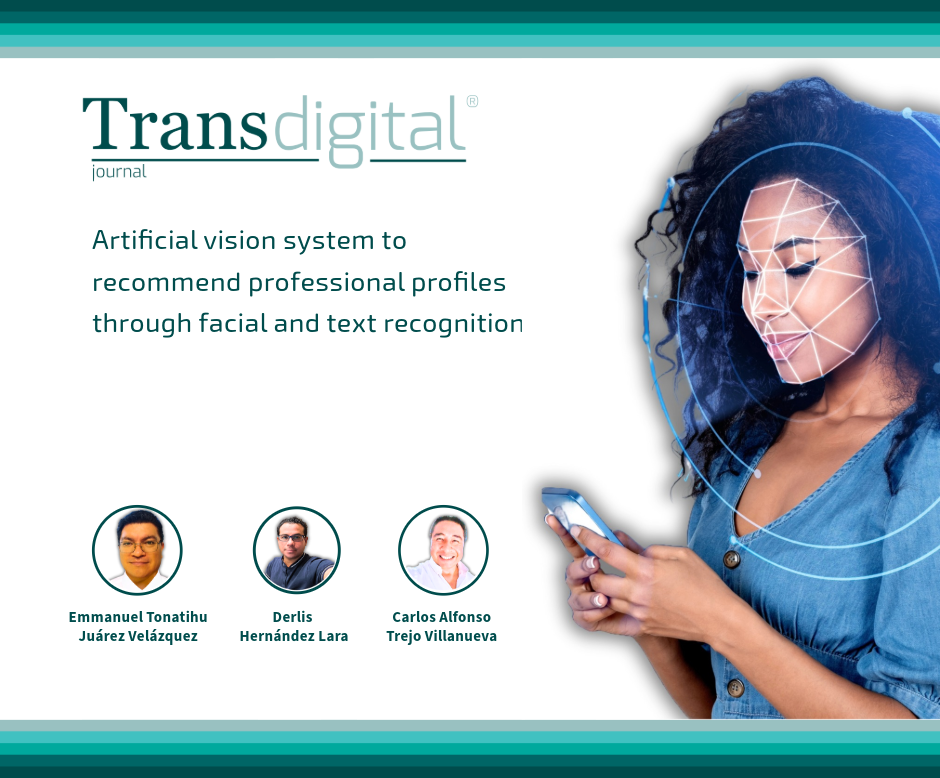Artificial vision system to recommend professional profiles through facial and text recognition
DOI:
https://doi.org/10.56162/transdigital362Keywords:
computer vision, facial recognition, handwriting recognition, professional profiling, vocational orientationAbstract
This research developed a computer vision system that uses facial and text recognition to recommend professional profiles. This with the aim of improving vocational guidance and personnel recruitment. The process was carried out at the Technological Higher Studies of Ecatepec, Mexico. The system employs advanced image processing and machine learning techniques in Python to evaluate facial and handwriting features. The results showed an accuracy of 87.5% in facial analysis and 85.93% in text analysis. Furthermore, an overall accuracy of 86.72% was achieved by combining facial and text analysis. Users indicated that they were satisfied with the recommendations received. However, ethical concerns are highlighted about possible discrimination when using artificial intelligence. Despite these challenges, the system represents a novel and effective tool for assigning professional profiles, benefiting both students and companies in the orientation and selection process.
References
Canul-Arceo, L., López Martínez, J. L., & Narváez-Díaz, L. (2015). Algoritmo rápido de la transformada de Hough para detección de líneas rectas en una imagen. Programación matemática y Software, 7(2), 8–13.
Codina Acedo, M. (2013). Manual completo de morfopsicología y la interpretación del rostro. Bubok Publishing S.L.
Doyle, J. R., & Bottomley, P. A. (2004). Font appropriateness and brand choice. Journal of Business Research, 57(8), 873-880. https://doi.org/10.1016/S0148-2963(02)00487-3
Hamermesh, D. S., & Biddle, J. E. (1994). Beauty and the labor market. The American Economic Review, 84(5), 1174-1194. https://www.jstor.org/stable/2117767
Holland, J. L. (1997). Making vocational choices: A theory of vocational personalities and work environments (3rd ed.). Psychological Assessment Resources.
Idelfonso-Romero, N. (2024). Grafología como herramienta científica para el análisis psicológico de la personalidad. Revista de Psicología de la Universidad Autónoma del Estado de México, 13(38), 174-191. https://doi.org/10.36677/rpsicologia.v13i38.24193
ISO. (2006). ISO/IEC 19795-1:2006 Information technology—Biometric performance testing and reporting—Part 1: Principles and framework. ISO. https://www.iso.org/standard/41447.html
LeCun, Y., Bengio, Y., & Hinton, G. (2015). Deep learning. Nature, 521(7553), 436-444. https://doi.org/10.1038/nature14539
Morales Olivera, Y., García Parrado, J., Reyes Fernández, P. E., & Lorenzo Ginori, J. V. (2012). Experiencias en la implementación de las operaciones morfológicas de erosión y dilatación para imágenes binarias empleando vecindades adaptativas. Ingeniería Electrónica, Automática y Comunicaciones, 33(2), 34-41.
Niño-Rondón, C. V., Castro-Casadiego, S. A., Medina-Delgado, B., Guevara-Ibarra, D., & Camargo-Ariza, L. L. (2021). Comparativa entre la técnica de umbralización binaria y el método de Otsu para la detección de personas. Revista UIS Ingenierías, 20(2), 65–74. https://doi.org/10.18273/revuin.v20n2-2021006
Ortiz Rangel, E., Mejía-Lavalle, M., & Sossa, H. (2017). Filtrado de ruido Gaussiano mediante redes neuronales pulso-acopladas. Computación y Sistemas, 21(2), 381-395. https://doi.org/10.13053/cys-21-2-2742
Rastogi, O. (2020). Working of Classifiers [Imagen]. Medium. https://medium.datadriveninvestor.com/haar-cascade-classifiers-237c9193746b
Serrador, P., & Pinto, J. K. (2015). Does Agile work?—A quantitative analysis of agile project success. International Journal of Project Management, 33(5), 1040-1051.
Suárez, P., & Villavicencio, M. (2017). Canny Edge Detection in Cross-Spectral Fused Images. Enfoque UTE, 8(1), 16–30. https://doi.org/10.29019/enfoqueute.v8n1.127
Sun, C., Shrivastava, A., Singh, S., & Gupta, A. (2017). Revisiting Unreasonable Effectiveness of Data in Deep Learning Era. En IEEE (Ed.), 2017 IEEE International Conference on Computer Vision (ICCV) (pp. 843-852). IEEE.
Tinto, V. (2017). Through the eyes of students. Journal of College Student Retention: Research, Theory & Practice, 19(3), 254-269.
Van Rossum, G., & Drake, F. L. (2009). Python 3 Reference Manual. CreateSpace.
Viola, P., & Jones, M. (2001). Rapid object detection using a boosted cascade of simple features. En IEEE (Ed.), 2001 IEEE Computer Society Conference on Computer Vision and Pattern Recognition (pp. 1-9). IEEE.
Zhao, W., Chellappa, R., Phillips, P. J., & Rosenfeld, A. (2003). Face recognition: A literature survey. ACM Computing Surveys (CSUR), 35(4), 399-458. https://doi.org/10.1145/954339.954342

Downloads
Autor de correspondencia
El autor de correspodencia se identifica con el siguiente símbolo: *Published
How to Cite
License
Copyright (c) 2024 Emmanuel Tonatihu Juárez Velázquez, Derlis Hernández Lara, Carlos Alfonso Trejo Villanueva

This work is licensed under a Creative Commons Attribution 4.0 International License.
All articles in Transdigital are licensed under a Creative Commons Attribution 4.0 International License. Authors hold the copyright and retain publishing rights without restrictions.









